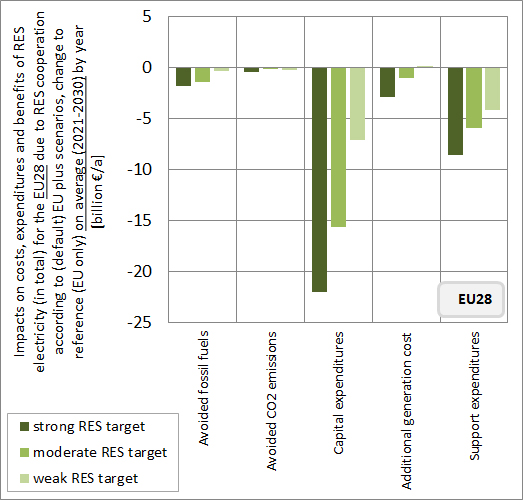
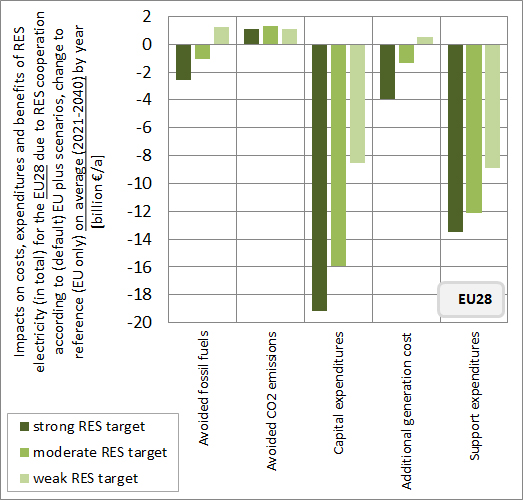
Extending the geographical scope of RES cooperation to the EU neighbours brings about monetary savings that can be expressed in terms of certificate price development. Benefits as well as costs associated with the use of renewables, in particular with renewable electricity, are influenced by RES co-operation. They are further measurable as changes in benefits - i.e. avoided fossil fuels and avoided CO2 emissions -, in investments (i.e. capital expenditures) and in costs - i.e. support expenditures and additional generation cost on the other.
Next we make a comparison of the resulting changes in costs and benefits associated with renewable electricity use at regional level, i.e. for the EU28, the Western Balkans, Turkey and North Africa. Thereby, changes are induced by enhanced RES cooperation (when moving from RES cooperation at EU level only (EU only) to full RES cooperation between all assessed regions). Moreover, please note that in order to simplify a comparison be-tween distinct categories, all values are expressed in monetary terms - i.e. for example avoided fossil fuel use is translated into avoided expenses for fossil fuels (with impact on a countrys trade balance) through multipli-cation of annual energy quantities with corresponding fossil fuel price trend assumptions, done in a dynamic way. In contrast to fossil fuels, for avoided CO2 emissions a constant carbon value of 80 EUR/ton CO2 is used for the monetary expression - in accordance with the approach taken for the assessment of environmental co-effects as done within this project.
European Union: As can be seen in Figure 4.5, an EU plus (full cooperation between EU28 Member States and Third countries) scenario leads to avoided fossil fuels in all different RES target cases, i.e. for the weak, moderate and strong RES target at EU level in the medium term. Specifically, for the strong RES target, EUR 1.8 billion could be saved, for the moderate target a slightly lower amount of EUR 1.4 billion annually and in the weak target case EUR 0.3 billion per year remain. In the longer term, this picture changes: for the weak target, fossil fuel use would have to increase between 2021 and 2040. Namely, fossil fuels to an amount of 1.2 billion EUR per year would have to be purchased annually. Concerning avoided CO2 emissions, costs that occur are quite low for the EU28 Member States in the full cooperation scenario. In the longer term, up to 2040, monetary benefits occur for the weak, moderate and strong target case.
Capital expenditures can be lowered substantially with full cooperation compared to the EU only (reference) scenario. With a strong target, EUR 22 billion can be saved annually. A moderate target induces lower capital expenditures in comparison to the reference case of 15.7 billion EUR. Even a weak RES target still leads to minus EUR 7.1 billion capital expenditures annually, or 20.6% less compared to the reference case.
The same pattern can be observed for support expenditures, whereas at a lower level. Support expenditures decrease substantially in the medium term, e.g. when assuming a strong RES target, EUR 8.6 billion can be saved annually up to 2030. Up to 2040, savings even increase up to EUR 13.5 billion per year. For the moderate and weak target, savings are lower but still visible with amounts of EUR 6.0 and 12.2 billion and EUR 4.2 and 8.9 billion respectively up to 2030 and 2040.


Figure 4-5: Impacts of enhanced RES cooperation on costs and benefits of renewable electricity for the EU28 in the medium (2021-2030) and long term (2021-2040) for a weak, strong and moderate RES target.
Additional generation costs fall for the strong and moderate RES target in the medium and long term perspective. Specifically, a decrease of EUR 2.9 billion per year for the strong target and EUR 1 billion per year for the moderate target can be observed in the medium term (up to 2030). When a weak RES target is assumed at EU level, these costs increase slightly compared to the reference (EU only scenario). In the medium term perspective (2021-2030) this means additional generation costs of EUR 0.1 billion per year. In the longer term (2021-2040) the increase is higher, namely amounting to EUR 0.5 billion/a.
Turkey: In Turkey, the costs and benefits evolve in the following way. Under a strong RES target, in the medium term, substantial savings occur in terms of avoided fossil fuels and avoided CO2 emissions. Expressed as monetary values, these amount to around 2 billion EUR each per year. For a moderate target, the amount falls, namely to EUR 1.3 and 1.5 billion respectively. In terms of capital expenditures, Turkey would have to expect additional expenditures of around EUR 4.7 billion per year in the mid-term. In the long term perspective, nevertheless, looking at the right hand side of Figure 4-6, the capital expenditures decrease whereas the benefits in terms of avoided fossil fuels and CO2 emissions increase. This shows that while in the beginning additional expenditures are quite substantial, the overall benefits are sustainable and at a constant level in the long term perspective.
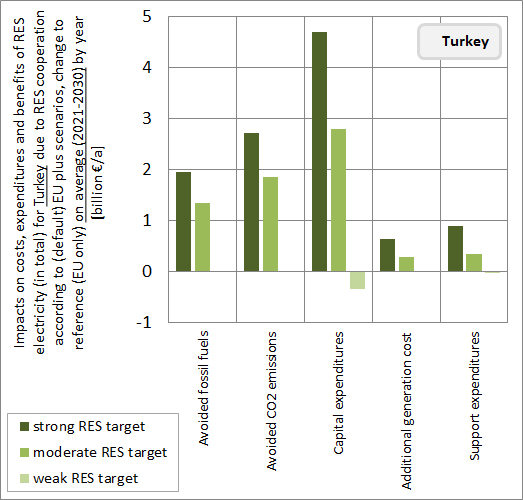
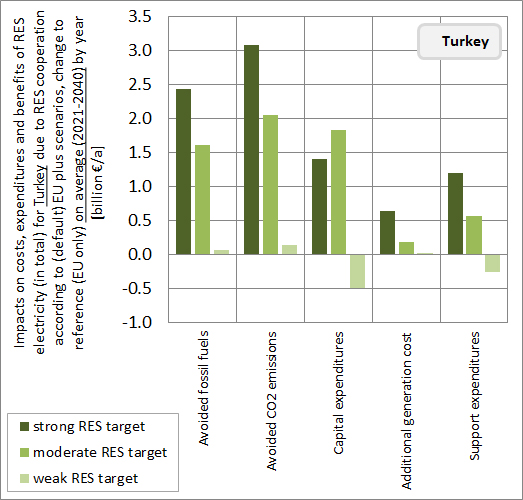
Figure 4-6: Impacts of enhanced RES cooperation on costs and benefits of renewable electricity for Turkey in the medium (2021-2030) and long term (2021-2040) for a weak, strong and moderate RES target.
The moderate target scenario exhibits lower capital expenditures at EUR 2.8 billion, which decrease to EUR 1.8 billion annually in the longer term. In comparison to the capital expenditures, additional generation cost as well as support expenditures are quite low. In the medium term, additional generation costs amount to EUR 0.6 billion for the strong target and to EUR 0.3 billion for the moderate target. In the longer term for the strong RES target, these costs stay at the same level, whereas they slightly decrease for the moderate target. Support expenditures amount to EUR 0.9 billion annually (strong target) or EUR 0.4 billion annually (moderate target) in the medium term. The long term scenario exhibits higher support expenditures in the strong and moderate target scenario (EUR 1.2 billion and EUR 0.6 billion per year respectively). The weak RES target scenario hardly exhibits any changes when it comes to additional generation costs or support expenditures. The only visible change occurs for support expenditures in the long term - a weak target for RES leads to decreasing support expenditures (annually EUR 0.3 billion).
Western Balkans: The Western Balkan region exhibits a slightly different pattern in the development of costs and benefits. Avoided expenses for fossil fuels range from EUR 0.3 (strong target for RES at EU level) to EUR 0.2 billion (moderate and weak target) annually for the medium term perspective. In the long term, benefits from avoided fossil fuels increase for a strong RES target and decrease for a weak target. Specifically, a strong target leads to EUR 0.34 billion per year, whereas a weak target induces a mere EUR 24 million annually. Looking at avoided CO2 emissions shows a similar development. Whereas in the medium term, benefits range between 0.3 (strong target) and EUR 0.2 billion (medium and weak target), the long term perspective shows that a strong and moderate RES target lead to sustainable benefits up to 2040, whereas a weak RES target has only little effect when one looks at a broader time frame.
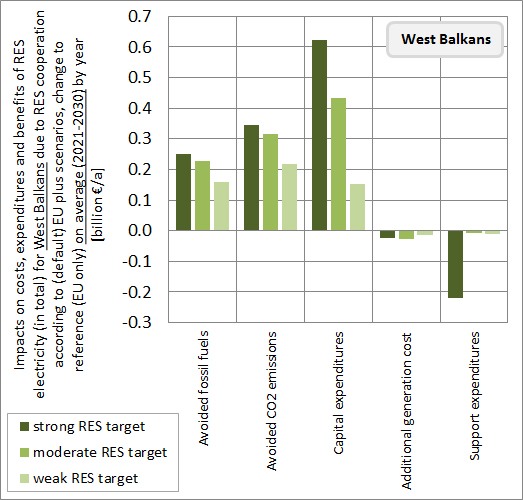
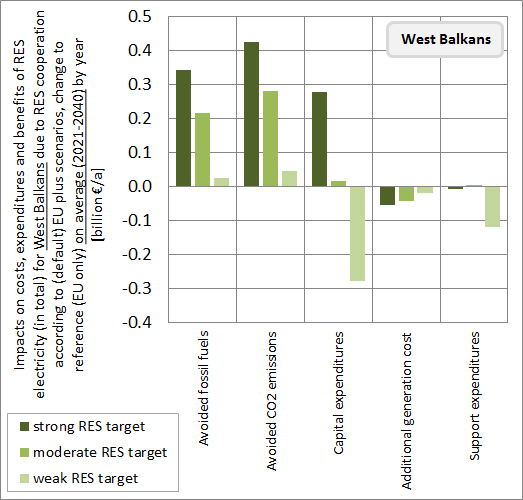
Figure 4-7: Impacts of enhanced RES cooperation on costs and benefits of renewable electricity for the Western Balkans in the medium (2021-2030) and long term (2021-2040) for a weak, strong and moderate RES target.
Looking at expenditures resulting from RES electricity deployment induced through RES cooperation between the EU28 Member States and the Western Balkans, the medium term shows an increase in capital expenditures of roughly EUR 0.6 billion annually for the strong target, whereas support expenditures decrease by more than EUR 0.2 billion. For the moderate and weak RES target scenarios, the capital expenditures also increase by EUR 0.4 and EUR 0.14 billion per year respectively up to 2030.
Support expenditures do not exhibit any significant changes throughout that period of time. In the long term perspective a strong RES target still exhibits substantially increased capital expenditures by roughly EUR 0.3 billion annually. A weak RES target on the other hand shows a decrease in roughly that dimension, whereas a moderate RES target hardly changes capital expenditures in the long term. Support expenditures decrease only slightly through cooperation under a strong RES target in the long term as compared to the more significant decrease in the medium term. Again, the moderate target seems to come with basically unchanged expenditures, whereas the weak RES target leads support expenditures to be around EUR 0.1 billion lower annually.
Generation costs decrease under all scenarios and, not surprisingly, the most significantly when looking at a strong RES target. Under a strong target and in the long term perspective, generation costs decrease by EUR 50 million annually. In the medium term, the savings amount to roughly half of that value.
North Africa: In North Africa, in the medium term, benefits from avoided fossil fuels are basically the same for each target, i.e. the strong moderate and weak RES target induce EUR 1.6 to 1.5 billion annual savings each. The avoided CO2 emissions lead to similar benefits: the savings amount to between EUR 1.8 and 1.7 billion per year. In the longer term (up to 2040), the targets still do not induce a large bandwidth of savings. Specifically, savings range from EUR 3.5 (strong target) to 3.6 billion (weak target) for avoided fossil fuels and from EUR 3.4 (strong target) to 3.6 billion (weak target) for avoided CO2 emissions.
Capital expenditures on the other hand vary greatly depending on the underlying target. A strong target requires additional capital expenditures of EUR 9.3 billion per year in the medium term. For a moderate target, this amount falls to EUR 6.3 billion annually and for a weak RES target, it amounts to EUR 2.5 billion annually in the medium term. In the longer term perspective, the expenditures are lower but show a similar pattern of namely EUR 8.2 billion per year for a strong, EUR 6.1 billion per year for a moderate and EUR 4.1 billion for a weak target. One can observe, that while expenditures are lower in the long term perspective for the most ambitious RES target, are hardly unchanged for the moderate target and increase in comparison to the medium term perspective for the weak target.
Generation costs decrease in the medium term by EUR 0.4 billion per year for all targets. In the long term, the decrease is getting smaller, amounting to annually EUR 0.2 billion for the strong and moderate and to EUR 0.3 billion for the weak target. Support expenditures on the other hand increase slightly in the medium term, amounting to annually EUR 0.4 billion for the strong RES target and EUR 0.2 billion for the moderate. There are no noteworthy support expenditures to be seen for the weak target in the medium term. In the long term, support expenditures decrease for all target scenarios in comparison to the reference case. Concretely, they fall by EUR 0.4 billion annually for the strong, by EUR 0.9 billion annually for the moderate and by EUR 1.5 billion annually for the weak target case.
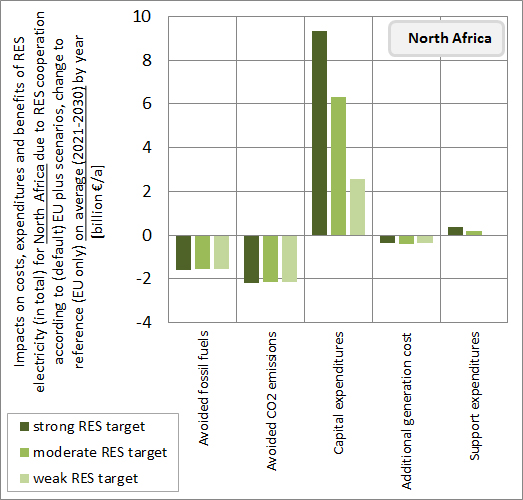
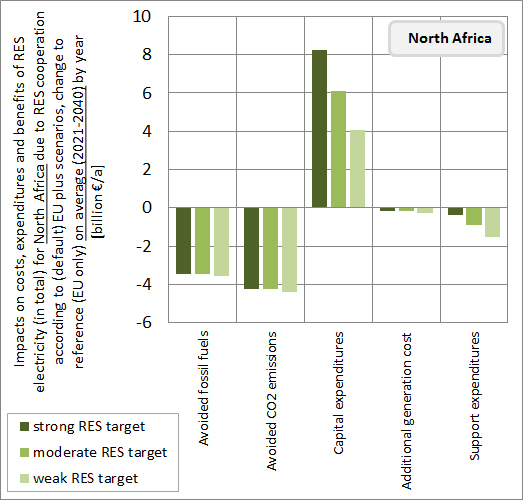
Figure 4-8: Impacts of enhanced RES cooperation on costs and benefits of renewable electricity for North Africa in the medium (2021-2030) and long term (2021-2040) for a weak, strong and moderate RES target.
| <<Back | >>Back to Introduction<< |